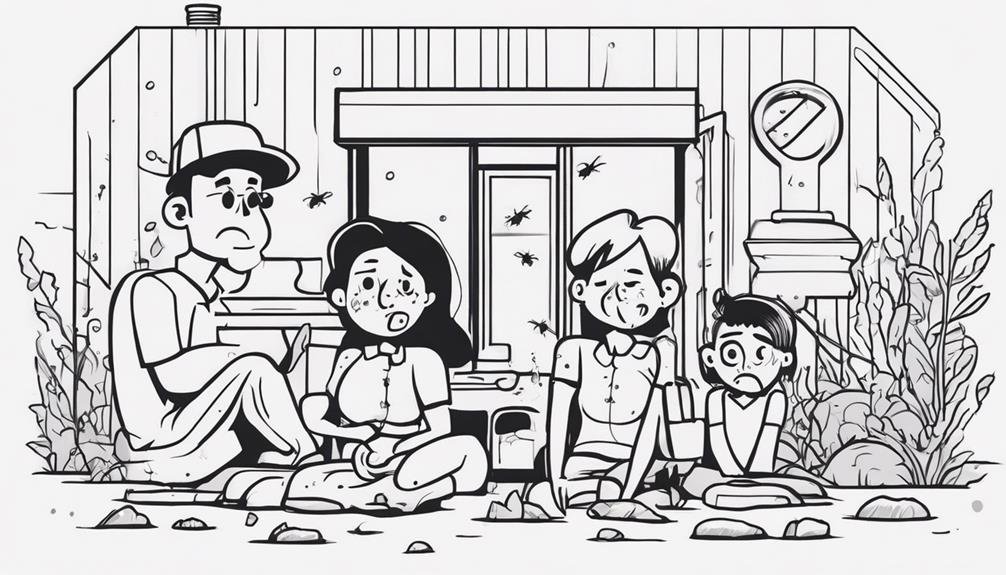If you've noticed some 'unpleasant odors' lingering around your property lately, it might be a sign of something more serious beneath the surface. Slow draining fixtures and unexpectedly lush green grass could also be subtle hints that something isn't quite right with your septic tank.
But what happens when these signs are ignored? The consequences could be more than just a nuisance. Keep an eye out for these signs to prevent potential issues before they escalate.
Key Takeaways
- Unpleasant odors signal septic tank issues; check for leaks and perform regular maintenance.
- Slow drainage indicates septic system problems; schedule professional inspections and pump the tank regularly.
- Lush green grass near the tank may indicate drainage issues; seek professional assessment and solutions promptly.
- Ignoring sewage backups can lead to costly repairs; prevent issues by addressing signs promptly and avoiding harmful practices.
Unpleasant Odors

If you detect foul smells emanating from your septic tank area, this could indicate a significant issue with its functionality. Odor control in your septic system is crucial for maintaining a pleasant environment around your property. Proper maintenance is key to preventing these odors from becoming a persistent problem.
To address unpleasant odors from your septic tank, start by checking for any visible signs of leaks or damage to the tank itself. Inspect the area around the tank for any pooling water or soggy ground, as this could indicate a leak. Ensure that all access points to the tank are properly sealed to prevent odors from escaping.
Regularly scheduled maintenance, including pumping out the tank as recommended by professionals, is essential for odor control. This helps prevent the buildup of solid waste and keeps the system functioning efficiently. Additionally, consider using septic-safe products and avoiding flushing harmful chemicals down your drains to maintain a healthy balance of bacteria in the tank.
Slow Draining Fixtures
When fixtures in your home start draining slowly, it may signal a potential issue with your septic system's functionality. Slow draining fixtures are often a warning sign that your septic tank needs attention. To address this problem, there are maintenance tips you can follow to prevent further issues.
First, consider scheduling a professional inspection to determine the root cause of the slow drainage. This can help identify common causes such as clogs in the pipes, a full septic tank, or issues with the drain field.
Regular maintenance, such as pumping your septic tank every 3-5 years, can help prevent slow drainage and more severe problems down the line. Additionally, be mindful of what you flush down your drains to avoid clogs that could lead to slow drainage. By being proactive and following these maintenance tips, you can keep your septic system running smoothly and avoid costly repairs in the future.
Lush Green Grass

To determine the health of your septic system, inspect the area around your tank for lush green grass as it may indicate potential issues. When your septic system is functioning correctly, the grass above the tank and drain field should appear similar to the rest of your lawn. However, if you notice an area of unusually lush and vibrant green grass around these areas, it could be a sign of soil saturation and drain field issues.
Soil saturation occurs when the septic tank is overflowing or leaking, causing excess moisture to accumulate in the surrounding soil. This excess water can lead to the growth of lush green grass as the grass benefits from the additional nutrients present in the wastewater. While the lush grass may seem visually appealing, it's essential to address the underlying septic system problem promptly to prevent further damage.
If left unchecked, drain field issues can escalate, resulting in sewage backup and costly repairs. Therefore, if you observe areas of unusually lush green grass near your septic tank, it's recommended to contact a professional to assess and address the potential septic system problems promptly.
Sewage Backup
Experiencing sewage backup in your home can be a distressing and potentially hazardous situation that requires immediate attention. Sewage backup is often caused by clogs in the sewer line, tree roots infiltrating the pipes, or a full septic tank. These issues can lead to sewage not being properly carried away from your home, resulting in backups that can cause damage and health risks.
To prevent sewage backup, it's crucial to be mindful of what's being flushed down the drains. Avoid flushing items like grease, paper towels, and feminine hygiene products, as they can contribute to clogs in the pipes. Regular septic tank maintenance, including pumping every 3-5 years, can also help prevent backups by ensuring the tank doesn't become too full.
If you notice signs of sewage backup such as gurgling noises in the drains, foul odors, or water backing up in sinks or toilets, it's essential to address the issue promptly. Ignoring sewage backup can lead to extensive damage and expensive repairs. Therefore, it's wise to take preventive measures and address any causes of potential sewage backup promptly.
Conclusion
In conclusion, recognizing the signs of septic tank failure is crucial for maintaining a healthy and functioning system. Just as a watchful eye can detect early warning signs of trouble, being vigilant for unpleasant odors, slow draining fixtures, lush green grass, and sewage backup can help prevent costly and messy issues down the line.
Stay alert to these indicators and address any concerns promptly to avoid a stinky situation.

